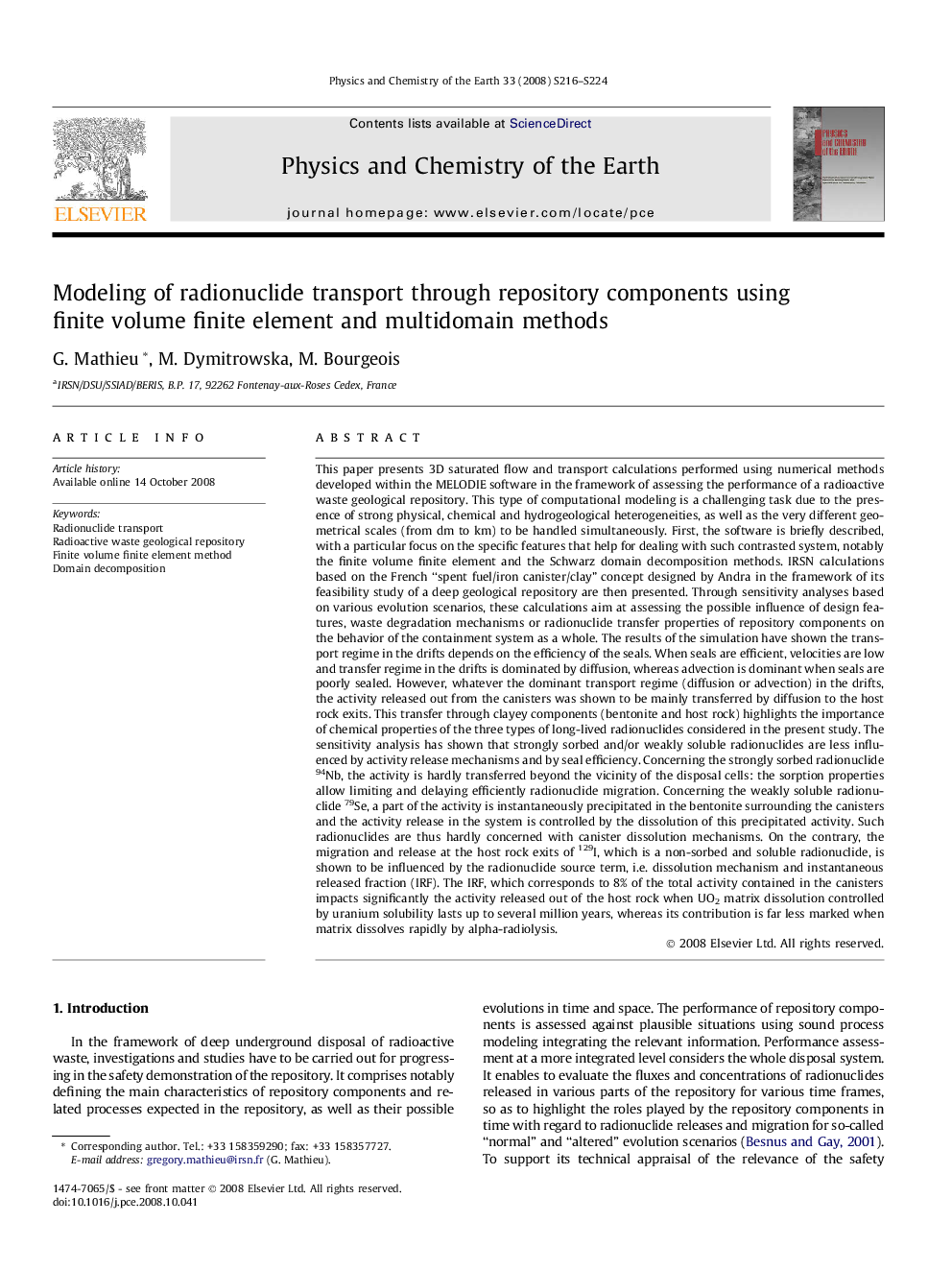| کد مقاله | کد نشریه | سال انتشار | مقاله انگلیسی | نسخه تمام متن |
|---|---|---|---|---|
| 4721628 | 1639402 | 2008 | 9 صفحه PDF | دانلود رایگان |
عنوان انگلیسی مقاله ISI
Modeling of radionuclide transport through repository components using finite volume finite element and multidomain methods
دانلود مقاله + سفارش ترجمه
دانلود مقاله ISI انگلیسی
رایگان برای ایرانیان
موضوعات مرتبط
مهندسی و علوم پایه
علوم زمین و سیارات
ژئوشیمی و پترولوژی
پیش نمایش صفحه اول مقاله

چکیده انگلیسی
This paper presents 3D saturated flow and transport calculations performed using numerical methods developed within the MELODIE software in the framework of assessing the performance of a radioactive waste geological repository. This type of computational modeling is a challenging task due to the presence of strong physical, chemical and hydrogeological heterogeneities, as well as the very different geometrical scales (from dm to km) to be handled simultaneously. First, the software is briefly described, with a particular focus on the specific features that help for dealing with such contrasted system, notably the finite volume finite element and the Schwarz domain decomposition methods. IRSN calculations based on the French “spent fuel/iron canister/clay” concept designed by Andra in the framework of its feasibility study of a deep geological repository are then presented. Through sensitivity analyses based on various evolution scenarios, these calculations aim at assessing the possible influence of design features, waste degradation mechanisms or radionuclide transfer properties of repository components on the behavior of the containment system as a whole. The results of the simulation have shown the transport regime in the drifts depends on the efficiency of the seals. When seals are efficient, velocities are low and transfer regime in the drifts is dominated by diffusion, whereas advection is dominant when seals are poorly sealed. However, whatever the dominant transport regime (diffusion or advection) in the drifts, the activity released out from the canisters was shown to be mainly transferred by diffusion to the host rock exits. This transfer through clayey components (bentonite and host rock) highlights the importance of chemical properties of the three types of long-lived radionuclides considered in the present study. The sensitivity analysis has shown that strongly sorbed and/or weakly soluble radionuclides are less influenced by activity release mechanisms and by seal efficiency. Concerning the strongly sorbed radionuclide 94Nb, the activity is hardly transferred beyond the vicinity of the disposal cells: the sorption properties allow limiting and delaying efficiently radionuclide migration. Concerning the weakly soluble radionuclide 79Se, a part of the activity is instantaneously precipitated in the bentonite surrounding the canisters and the activity release in the system is controlled by the dissolution of this precipitated activity. Such radionuclides are thus hardly concerned with canister dissolution mechanisms. On the contrary, the migration and release at the host rock exits of 129I, which is a non-sorbed and soluble radionuclide, is shown to be influenced by the radionuclide source term, i.e. dissolution mechanism and instantaneous released fraction (IRF). The IRF, which corresponds to 8% of the total activity contained in the canisters impacts significantly the activity released out of the host rock when UO2 matrix dissolution controlled by uranium solubility lasts up to several million years, whereas its contribution is far less marked when matrix dissolves rapidly by alpha-radiolysis.
ناشر
Database: Elsevier - ScienceDirect (ساینس دایرکت)
Journal: Physics and Chemistry of the Earth, Parts A/B/C - Volume 33, Supplement 1, 2008, Pages S216-S224
Journal: Physics and Chemistry of the Earth, Parts A/B/C - Volume 33, Supplement 1, 2008, Pages S216-S224
نویسندگان
G. Mathieu, M. Dymitrowska, M. Bourgeois,